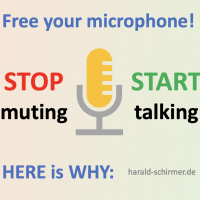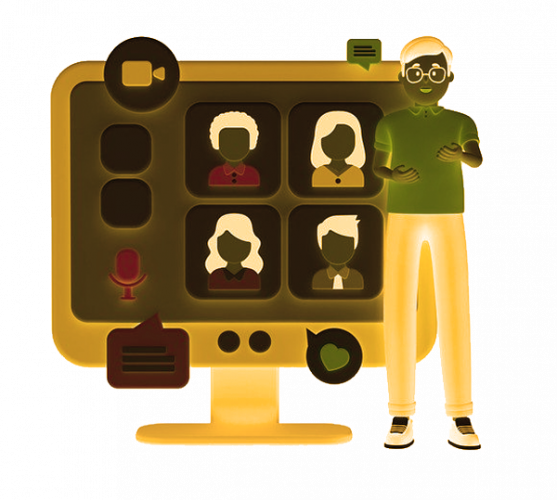In this post, I share my tips to solve this problem:
You are in an online meeting or virtual conference, the moderater asks a question… and no one answers – awkward silence … the moderator continues speaking (frustrated). The result: All think „virtual calls don’t work“ or „people do not (want to) interact. In cross-cultural sessions, inviting people to contribute seems even harder.
virtual sessions can be highly engaging, participative and productive, if done right!

As personal exchange, interaction and a high level of participation has always been my goal, I was experimenting for many years in local and global, small and big size events with hundreds of people.

Technology evolved and offers a wide rang of options to personally or anonymously involve individuals or „all“. Modern participation methods support this as well (if known and moderators know how to apply them virtually or even in hybrid events).
Liberating Structures is the probably most known set of involvement methods.
Here I want to focus on behaviors and little but powerful tips for moderators to increase engagement in sessions of any size. This are „level 2“ tips, so I leave out the absolute fundamental stuff like „turn on your camera, look into the camera“ or „test your audio equipment and lighting“ to make yourself understandable and visible“.
Click here if you need more infos about using equipment for virtual/hybrid session.
Before we start, one of the biggest mistakes of virtual calls: MUTING kills participation, so don’t tell people to „Mute their microphones“ when starting a session – that is a signal to „shut up“ – believe me… they will … the whole meeting. Stay unmuted yourself, so you can have an uninterrupted conversation flow.

Click here to learn more why muting kills interaction and engagement.
Here are my tips to make your session „lively“ and interactive:

Of course it depends if the group knows each other or not, if it is a first time meeting or regular call, but generally they all work – just adjust the questions you ask
What to DO:
- Dial in a bit earlier – the first ones joining are often the curious ones, where it is easier to start talking to
- Start a conversation immediately with the first person dialing in
- Welcome the first participants individually with their name (in large crowds keep welcoming some people and ask them to do that as well in the chat – maybe including their home town, country or in their mother language)
4. Always talk to individuals with their name (don’t ask „into the crowd“)
- Start asking „generic, simple“ questions, everyone can answer (where are you from? what is the weather like there? how did you learn about this event?)
- Be clear and tell, HOW people should start talking (raise physical hand, click raise hand, just start speaking, entering a chat message first…) – be consistent and role model it yourself
- Ask them to hand over to a next person (and role model it)
- Ask clear, short questions – one sentence max
- Use your voice, engagement, eyes, gestures to a level, you want to see from the others (to light a fire, you need to burn)
- Be fair, whom you invite to talk (try to invite multiple people, tell them your order e.g. participant list, raised hand sequence – reduce surprises)
- Learn active listening – you will feel, once people develop a DESIRE to contribute
- Leave time to think (time goes by faster for you, than others while waiting – count to 10) – than ask the first person by name, if no one joins in
- Use polls to start with – low level engagement first
14. Treat „introverts“ with special respect – not everyone wants to be „on stage“
give them options via polls, word-clouds, chat, whiteboards – their input is of great value!
- Invite people to use the chat for their questions – specially in international sessions (leaves them time to think, translate, spelling)
- Observe the chat and throw those questions in
- Ask back if you are not clear (most likely others are not either)
- Write protocols transparently – people see, what you understood (and often help by telling shorter sentences – if not, ask them how you should write it)
- Be appreciative from start – make people feel great participating actively (Make them „wanting“ to talk)
- When sending people to break out sessions – ensure you have something great, when they come back (providing a summary is not) – Build in a „cliff-hanger“ like in movies, where at the end a relevant turnaround is started to make people curious and coming back
The DO NOT list for virtual sessions:

- Don’t give up early – people have to get used to interaction
- Ask or sense participants emotional situation, sometimes something happened, which needs to be taken care of first (fear, personal loss, critical..) Do not try to jump right into topics when your people suffer from anything – they can not concentrate (ask about the issue, show respect, maybe postpone)
- Ask your self: Is my stuff REALLY relevant for my target group – don’t bother people with boring information or „leading questions“
- Don’t start with emotional, critical topics
- Don’t hold long monologues (people lean back and switch to passive-mode)
- Don’t „immediately“ stopp talking with a question – prepare your „audience“ to become active in a minute: „After I finish, I would love to get your feedback/insights…“ than finish your talk, followed by the invitation to now talk.
7. Do not rush or tell „we are behind schedule“ or „hurry up“ – this are absolute motivation killers!
- Do not do anything else, once others are talking – show your absolut curiosity! (If people see that, they feel ignored, unimportant. If you are writing protocol – tell them or better write it transparently via sharing)
- Do not cut someone off impolitely – if people take „too much air time“ – who is their role model? maybe you? You could ask: „it seems to be a bitter topic – which other topic should we skip, or can we clarify this in an extra session?“
- Don‘t expect „everyone“ to be fully active – start with the „easy“ ones and grow with the majority
- Sharing feelings is ok, but no anger or bad mood – if you can not make it a positive experience, postpone it! (Also negative issues can be handled positively!)
Following and practicing those tips, I hardly ever experience unwanted silence or missing participation. It takes time to master them – as every group is different and sometimes the frame conditions, your own mood or something happening in the world has big impact.
Still I see it as my responsibility to make every session „something to remember“, a chance to build relationships and reputation, to learn and to build trust.
As this list surely is not „all you can do“ – I would love to learn what tips helped you… in the comments (I will add them to the list with your credentials)

Schreibe einen Kommentar